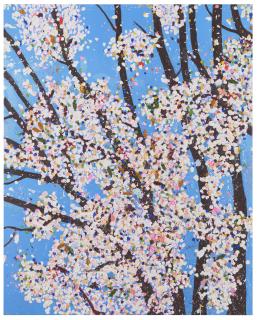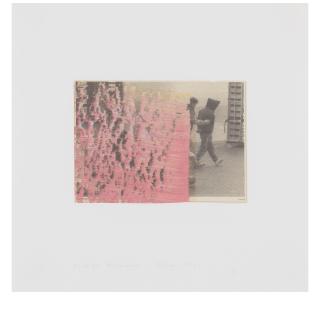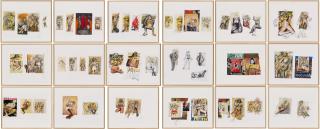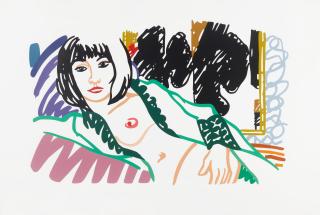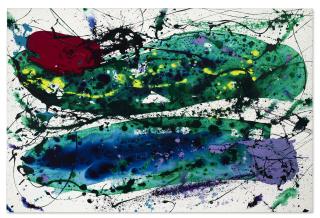Anish Kapoor born 1954 in Mumbai, India
The artist Anish Kapoor
- Indian-British sculptor who lives and works in London.
- Known for his large-scale abstract sculptures in public spaces.
- Secured exclusive rights to the substance Vantablack in 2016.
Indian-British sculptor Sir Anish Kapoor was born in Mumbai on March 12, 1954, the son of an Indian Hindu and a Jewish Iraqi. Specializing in installation and conceptual art, he is now one of the world's most respected contemporary artists. At the age of 16, Kapoor moved from India to Israel and on to London in 1973. There he studied art first at Hornsey College of Art and later at Chelsea College of Art and Design.
As early as the 1970s, he gained international attention with his monochrome spatial installations. Over time, they developed into geometric or biomorphic sculptures as well as monumental sculptures made of unusual materials. From 1979 he taught at Wolverhampton Polytechnic and in 1982 was a visiting artist at the Walker Art Gallery in Liverpool. In 1990 Kapoor participated in the Venice Biennale, and two years later in Documenta IX in Kassel. In 1991 he received the Turner Prize, which was joined by many other prizes and awards throughout his life. These include the Indian Order of the State Padma Bhushan (2012) and an honorary membership at the American Academy of Arts and Letters (2012). In addition, Kapoor was knighted in 2013 for his work in the visual arts.
Among Kapoor's best-known public sculptures is Cloud Gate (2006), also known as »The Bean.« The 100-ton, bean-shaped stainless steel sculpture is located in Chicago's Millennium Park.
Sky Mirror, which was exhibited at Rockefeller Center in New York City in 2006 and Kensington Gardens (London) in 2010, as well as Leviathan (2011) at the Grand Palais in Paris, are other popular works. Dresden's Frauenkirche also houses an altar made by Kapoor in black Irish limestone. His works are part of the collections of many international museums, including the Museum of Modern Art (New York City), the Tate Modern (London), the Art Gallery of New South Wales (Sydney), the Guggenheim (Bilbao), the 21st Century Museum of Contemporary Art (Kanazawa, Japan), and the Israel Museum (Jerusalem).
Kapoor is known for large-scale, abstract sculptures in public spaces. His works show influences from Western and Eastern cultures in equal measure, and in some cases feature religious themes. His earlier works in particular were characterized by simple, curved forms that are often monochromatic and brightly colored. Overall, Kapoor works with a variety of materials, including stone, wax, PVC, and colored pigments. He pays particular attention to negative spaces, such as openings and hollow bodies, and explores geometric and organic forms. After Kapoor began working with Vantablack-a barely reflective substance-in 2014, he secured exclusive rights to the material in the field of art in 2016. These usage rights generated much criticism and represent an ongoing controversy in the art world.
Der Künstler Anish Kapoor
- Indisch-Britischer Bildhauer, der in London lebt und arbeitet.
- Bekannt für seine großformatigen, abstrakten Skulpturen im öffentlichen Raum.
- Sicherte sich 2016 die Exklusivrechte an dem Stoff Vantablack.
Der indisch-britische Bildhauer Sir Anish Kapoor wurde am 12. März 1954 in Mumbai als Sohn eines indischen Hindu und einer jüdischen Irakerin geboren. Spezialisiert auf Installations- und konzeptionelle Kunst gehört er heute zu den weltweit angesehensten zeitgenössischen Kunstschaffenden. Mit 16 Jahren zog Kapoor von Indien nach Israel und 1973 weiter nach London. Dort studierte er zuerst am Hornsey College of Art und später am Chelsea College of Art and Design Kunst.
Schon in den 1970er Jahren erlangte er mit seinen monochromen Rauminstallationen internationale Aufmerksamkeit. Sie entwickelten sich mit der Zeit zu geometrischen bzw. biomorphen Skulpturen sowie zu Monumentalskulpturen aus ungewöhnlichen Werkstoffen. Ab 1979 unterrichtete er an der Wolverhampton Polytechnic und war 1982 Gastkünstler an der Walker Art Gallery in Liverpool. 1990 nahm Kapoor an der Biennale in Venedig, zwei Jahre darauf an der Documenta IX in Kassel teil. 1991 erhielt er den Turner-Preis, zu dem sich im Laufe seines Lebens noch viele weitere Preis und Auszeichnungen gesellten. Darunter der Indische Staatsorden Padma Bhushan (2012) sowie eine Ehrenmitgliedschaft der American Academy of Arts and Letters (2012). Darüber hinaus wurde Kapoor aufgrund seiner Arbeit in der bildenden Kunst im Jahr 2013 zum Ritter geschlagen.
Zu Kapoors bekanntesten öffentlichen Skulpturen gehört Cloud Gate (2006), auch bekannt als »The Bean«. Die 100 Tonnen schwere, bohnenförmige Edelstahlskulptur befindet sich im Millennium Park in Chicago.
Sky Mirror, welches 2006 im Rockefeller Center in New York City und 2010 in den Kensington Gardens London ausgestellt wurde, ebenso wie Leviathan (2011) im Grand Palais in Paris, sind weitere populäre Werke. In der Dresdner Frauenkirche befindet sich zudem ein von Kapoor angefertigter Altar aus schwarzem irischem Kalkstein. Seine Werke sind außerdem Bestandteil der Sammlungen vieler internationaler Museen, darunter das Museum of Modern Art (New York City), das Tate Modern (London), die Art Gallery of New South Wales (Sydney), das Guggenheim (Bilbao), das 21st Century Museum of Contemporary Art (Kanazawa, Japan) und das Israel Museum (Jerusalem).
Kapoor ist für großformatige, abstrakte Skulpturen im öffentlichen Raum bekannt. Seine Arbeiten zeigen gleichermaßen Einflüsse von westlichen und östlichen Kulturen und weisen zum Teil religiöse Themen auf. Vor allem seine früheren Werke zeichneten sich durch einfache, geschwungene Formen aus, die oftmals einfarbig und in leuchtenden Farben gehalten sind. Insgesamt arbeitet Kapoor mit verschiedenen Werkstoffen, darunter Stein, Wachs, PVC und Farbpigmente. Ein besonderes Augenmerk legt er dabei auf negative Räume, wie Öffnungen und Hohlkörper und erforscht geometrische und organische Formen. Nachdem Kapoor im Jahr 2014 mit Vantablack – einer kaum reflektierenden Substanz – zu arbeiten begann, sicherte er sich 2016 die Exklusivrechte an dem Stoff im Bereich der Kunst. Diese Nutzungsrechte sorgten für viel Kritik und stellen eine andauernde Kontroverse in der Kunstwelt dar.
Anish Kapoor in a nutshell
Kapoor's early works are strikingly brightly colored sculptures with flowing forms. They are made of bold colored pigments, the kind often sold in front of temples in Kapoor's native India. Beginning in the 1990s, he used red wax, which became his signature. For Kapoor, this red symbolizes his homeland. In the 21st century, installations with mirrors and reflective surfaces are mixed into his oeuvre. Viewers see a distorted image of themselves.
Vantablack is a pigment for which Kapoor bought the artistic rights in 2016. It is considered the blackest black in the world.
Häufige Fragen zu Anish Kapoor
Kapoors frühe Arbeiten sind auffallend leuchtend farbige Plastiken mit fließenden Formen. Sie bestehen aus kräftigen Farbpigmenten, wie sie in Kapoors Heimatland Indien oft vor Tempeln verkauft werden. Ab den 1990ern verwendete er rotes Wachs, das sein Merkmal wurde. Für Kapoor symbolisiert dieses Rot seine Heimat. Im 21. Jahrhundert mischen sich Installationen mit Spiegeln und reflektierenden Oberflächen in sein Œuvre. Betrachtende sehen ein verzerrtes Bild von sich selbst.
Vantablack ist ein Pigment, für das Kapoor 2016 die künstlerischen Rechte kaufte. Es gilt das das schwärzeste Schwarz der Welt.
Anish Kapoor quotes
Zitate von Anish Kapoor
Anish Kapoor in News and Exhibitions
Lehmbruck Prize goes to Anish Kapoor
The Gallerie dell'Accademia in Venice presents Anish Kapoor
The Gallerie dell'Accademia in Venice is dedicating a comprehensive exhibition to Indian-British artist Anish Kapoor beginning April 20th. This looks at both older and new works by the pioneering artist. In addition to the museum, the exhibition will also be on view at the historic Palazzo Manfrin.
Anish Kapoor in News and Exhibitions
Lehmbruck-Preis geht an Anish Kapoor
Die Gallerie dell'Accademia in Venedig präsentiert Anish Kapoor
Die Gallerie dell'Accademia in Venedig widmet dem indisch-britischen Künstler Anish Kapoor ab dem 20. April eine umfassende Ausstellung. Diese befasst sich sowohl mit älteren als auch neuen Werken des bahnbrechenden Künstlers. Neben dem Museum wird die Ausstellung auch im historischen Palazzo Manfrin zu sehen sein.






























